#equitists
Text
By: Robert F. Graboyes
Published: May 9, 2023
There’s a move afoot to replace America’s aspirational goal of equality (equal opportunity and equality under the law) with “equity” (equal outcomes designed and implemented by elite experts). A sprawling industry has arisen to spread the gospel of equity across American life. Its catechism has been greatly assisted by an internet-wide burst of colorful little visual parables, all purporting to show the difference between the sins of equality and the blessings of equity. Google “equity,” and your screen will explode with cartoons involving baseball games, apple orchards, blackboards, bike races, street crossings, bookshelves, and more. All of these myriad representations share one identical message.
A web page at the George Washington University’s School of Public Health uses an apple tree metaphor whose lesson seems to be that if you don’t have the sense to move your ladder to the side where the apples are, it’s “inequitable” and someone should install scaffolding and cables to bend the tree toward wherever you stuck your ladder. The website then conjures up a “Magic Benefactor” to explain equality and equity. It’s magic because deserving people are “given” and “allocated” resources, apparently without anyone else required to give up those resources:
“Equality means each individual or group of people is given the same resources or opportunities. Equity recognizes that each person has different circumstances and allocates the exact resources and opportunities needed to reach an equal outcome.”
As anyone with a knowledge of history and political philosophy knows, a sizable number of countries spent much of the 20th century trying to allocate the exact resources and opportunities needed to reach equal outcomes. The results were far less than equitable. However, as any Swiss banker can tell you, the rulers of these countries did accumulate considerable equity while impoverishing their countries.
Equity folks have another visual homily, the Stadium & Fence meme, that is brilliantly clever. It’s simple, intuitive, and heartwarming. It is also naïve, misleading, and hubristic. Let’s explore this meme and nine ways in which it fails.
The Basic Stadium & Fence Meme
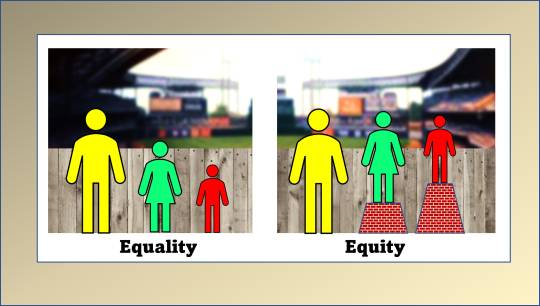
Three people—Mr. Tall, Ms. Medium, and Mr. Short are all trying to watch a baseball game over a fence. On the left, we see the odious world of equality. Mr. Tall has a clear view. Ms. Medium can barely see the field over the fence. Mr. Short cannot see over the fence at all. On the right, in the putatively just world of equity, some Magic Benefactor has allocated a small pedestal to Ms. Medium and a large pedestal to Mr. Short so all three now have equally clear views of the game. To put it another way, “To each according to his needs.”
Problem #1: “Inequality” is labeled “Equality.”
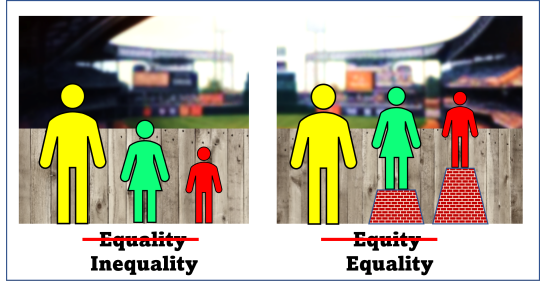
The left-hand picture doesn’t represent “equality.” An egalitarian would say that the left-hand picture represents inequality—an unfortunate but universal aspect of the human condition. The right-hand picture represents equality—a condition to which an egalitarian aspires, fully cognizant that it will never be fully realized. Bad luck, injustice, one’s starting point in life, and one’s own personal choices inevitably lead to some measure of inequality. Siblings of equal intelligence, from the same household, with identical opportunities often end up in vastly different levels of well-being. The Magic Benefactor can allocate all the resources it wants to Fredo, but he’s never going to be Michael.
Problem #2: The meme assumes an omniscient, omnipotent planner.
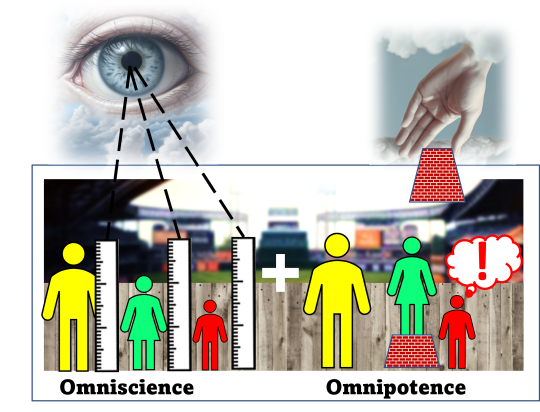
With the Magic Benefactor, individuals are helpless, passive beings, devoid of agency. Under equality, an individual is “given” resources and opportunities. Under equity, some unspecified being “allocates” resources and opportunities. In fact, these unnamed allocators are so perceptive and so powerful that they can allocate “the exact resources and opportunities needed to reach an equal outcome.” This is no Book of Job or Leibniz theodicy problem—where bad things happen to good people. Rather, it is Candide, where Dr. Pangloss always proclaims this to be the best of all possible worlds.
Problem #3: Redistribution can fail or make things worse.
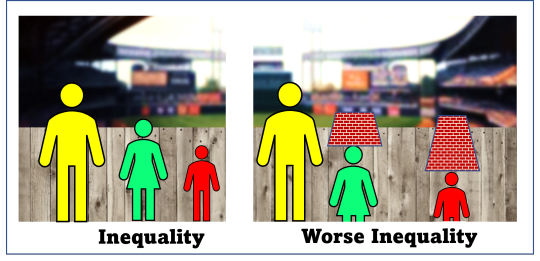
The past century was littered with redistributive schemes designed to achieve equality of outcomes and which ended in failures. There are monstrous cases, like China’s Cultural Revolution. But also benign cases, like America’s well-intended, but frustratingly ineffective War on Poverty. Central planning (i.e., allocating “the exact resources and opportunities needed to reach an equal outcome”) has a remarkable history of ineffectiveness and counterproductivity—where sincere effort to improve the lot of those at the bottom ensnares them in a poverty trap.
Problem #4: Maybe the tall guy sinks or leaves.

The Stadium & Fence and the Magic Benefactor ignore the fact that with redistribution, the reallocated resources come not like manna from Heaven, but rather from the pockets of living, breathing humans. A more realistic version of this metaphor would show Mr. Tall sinking as Ms. Medium and Mr. Short rise. Or perhaps Mr. Tall just packs up and moves away—leaving no one to pay for the pedestals for Ms. Medium and Mr. Short. This is known in governance as “eroding the tax base” and in folklore as “killing the goose that laid the golden eggs.” In the 1960s, President Lyndon Johnson’s top economic advisor, Arthur Okun, explained this phenomenon beautifully in terms of a leaky bucket.
Problem #5: Maybe those in charge have their own bigotries.
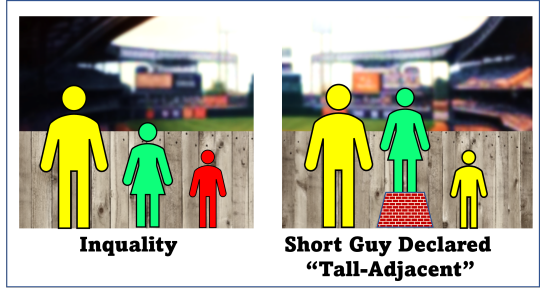
Unlike expert allocators in the Stadium & Fence and the Magic Benefactor, people in charge of real-world redistribution programs are not saintly, unbiased individuals. They come with their own collections of bigotries and deficits of introspection, all reflected in the policies they impose on others. You are disadvantaged only if the elite experts declare that you are disadvantaged. In recent years, for example, Asian-Americans, who suffered terrible discrimination over the course of U.S. history, have been declared by equity “experts” to be “white-adjacent” and, hence, on the losing side of redistribution programs. This reclassification is entirely arbitrary. Coincidentally, the apartheid regime in South Africa implemented a nearly identical redefinition of Japanese, Koreans, and Taiwanese people as “honorary whites”—for entirely cynical reasons.
Problem #6: Maybe the privileged experts in charge just use equity as a pretext to seize more privilege.

One of the more intriguing aspects of the equity agenda is that its proponents effectively say, “Governments, corporations, and educational institutions are hellholes of bigotry and discrimination—so let’s empower governments, corporations, and educational institutions to redistribute resources.” This is popularly known as, “Asking the fox to guard the chicken coop.” It is informative to note the rapidly rising salaries and numbers of equity experts employed by governments, corporations, and educational institutions.
Problem #7: Redistribution focuses on group averages, not individuals.
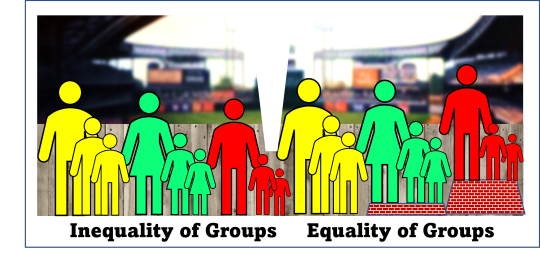
The Stadium & Fence and Magic Benefactor are both stated in terms of individuals, whereas, in reality, policies are applied to broad demographic groups. In this picture, the Talls are taller on average than the Mediums, who are taller on average than the Shorts. But there wide ranges within each category. Equity policies do not aspire to equalize individuals, but, rather, to equalize group averages. So, for example, when the pedestals are “given/allocated” to the Mediums and Shorts, the shortest member of each group, Talls, Mediums, and Shorts, is still unable to see over the fence, whereas the tallest member of the Shorts—who already had a good view of the game—now has an even better view of the game.
Problem #8: Maybe the problem is the fence, not the people.
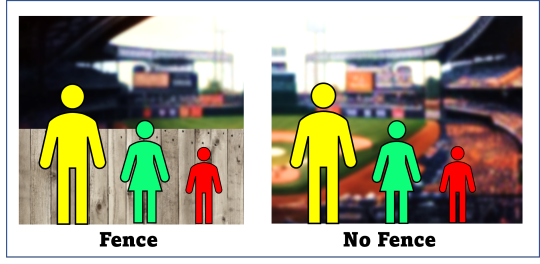
The Stadium & Fence meme never bothers to ask how the obstructive fence got there in the first place. A likely explanation is that the fence was erected by the very people with whom equity experts are entrusting with the task of reallocating resources. Access to healthcare, for example, is often impeded by government regulations that limit the number of doctors, that arbitrarily limit the scope of practice of nurse practitioners, that require hospitals to beg for permission to build new neonatal intensive care units—and enrich established insiders. Rather than obsessing over group averages on health, income, education, etc., perhaps the better approach is to rip down the obstacles that self-interested or misinformed bureaucrats and politicians and others have imposed on others.
Problem #9: Maybe the whole fence analogy is deceptive and elitist.
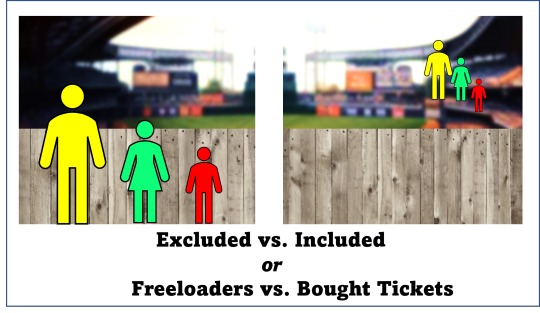
Finally, few, if any, have asked an obvious question that the Stadium & Fence metaphor begs: ”Why are we obsessing over equalizing viewing by three people trying to watch the game from outside the stadium?” There are two possible reasons why these three are where they are, struggling with the fence, rather than enjoying hot dogs in the bleachers with tens of thousands of other people. First, they may be victims of discrimination—excluded somehow from the stadium. If that’s the case, then equity experts are effectively saying, “It’s fine that these three can’t come into the stadium and sit next to us, but let’s make sure these second-class citizens all get the exact same inferior view of the game from the other side of the fence.” Second, perhaps these three are fully capable of buying tickets to the game but choose, instead, to peer over the fence for free. In which, case, why should anyone worry about how well any of them can steal a view of the game?
==
Unequal outcomes are not inherently unfair.
If the over-the-fence is a medical license, and height is ability to meet the requirements, then those who can't reach the top of the fence shouldn't get to see over it.
If the over-the-fence is entry to Harvard and height is test scores, then those who can't reach the top of the fence shouldn't get into Harvard. And yet, that's exactly what happened.
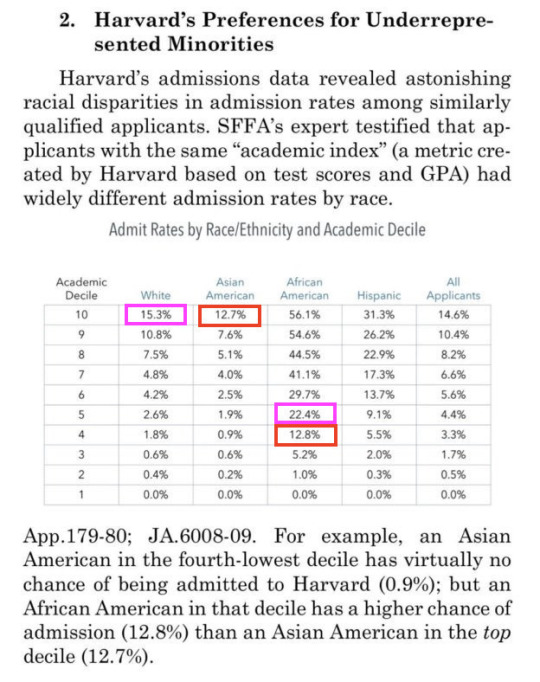
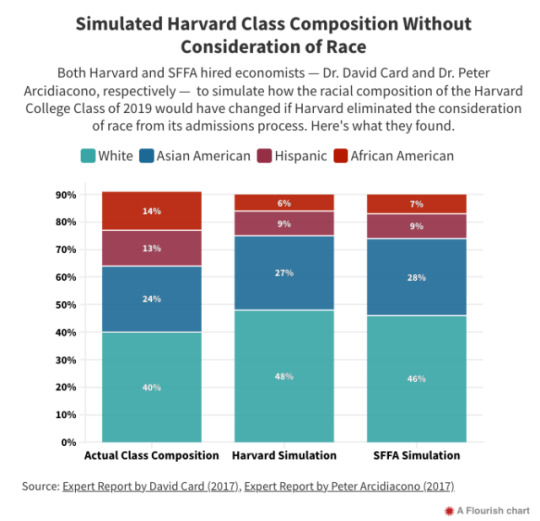
#Robert F. Graboyes#equity#equitism#equitists#equality#equality vs equity#equity vs equality#diversity equity and inclusion#DEI#DEI bureaucracy#stadium and fence meme#religion is a mental illness
9 notes
·
View notes
Text
I'm an equitist.
I think it's very important for society to provide equity for everyone. This means fair, impartial treatment (instead of there being biased favouritism); ensuring each human gets a chance to live their life well.
I want classism, ableism, sexism (& intersexphobia & misogyny & misandry), transphobia (& transandrophobia/transmisandry & transmisogyny & enbephobia), biphobia, arophobia, acephobia, homophobia (& lesbiphobia), islamophobia, antisemitism, and racism to end!!
0 notes
Text
Animated Sex at Adult Wedding
Young hottie sits her great round ass on a thick hard penis
Casting BTS compilation Desperate Amateurs Behind the scenes bbw big tits cock sucking action in int
Youtuber Novinho no Desafio Banho de Cueca (Aham, sei?)
Daddy girl xxx Tender Sex in Jacuzzi
Young College girl at Superdry Store Belgium whant fuck you and gangbang some people
Big dick twink pissing and jacking off until he cums
Big Shaved Shemale Dick
Namorada safada ninfetinha
Sexy Ebony Tart Ashley Pink Sucks a Big Black Dick Before Taking It in Her Cunt
#medioventral#forpining#homochrome#lamentingly#unrectifiably#twizzle#kingdomship#undepressible#metoestrus#nonpurposively#unplunderous#fummle#wallaroo#etiologically#equitist#apocopated#dependancy#Gengkow#tractor's#three-class
0 notes
Text
Find the Word Tag
Thanks for the tag, @kyofsonder!
My words: voice, equal, second, purpose, and greed.
voice:
“Alright,” he said, “once I pass back your test, you are dismissed.” He went, from row to row, handing back papers and whispering condolences or congradulations, in a voice old not just in age but in manner too, the same cadence that must have been used to announce Einstein’s special relativity, the cracking of the Enigma code, or the discovery of the Higgs Boson over 200 years ago. It was a voice that brought one back to a time when there were still hills and moors filled with heather, overseen by rainy, damp weather instead of the City’s near-perpetual sun.
equal:
somehow this only comes up once
“I was born in Leifen, under the monarchy. My parents had two children. Two daughters. They taught us to take the world in our hands; to change it for the better. When we got older Anne joined the Equitist Party. She wanted to overthrow the monarchy and establish a completely equal society. I wanted to help others, so I traveled abroad to Seranid, where Ethan found me and brought me into his Resistance."
second:
I watched him out of the corner of my eye, worried that I would break down if I faced him. “I’ll be fine,” I said, more to the smudged outline of the Slums than to him. I fumbled with the throttle for a second; Anjali glanced at me and we gave each other a nod. We turned as one and sped off, the wind visceral against my skin, trailing its long fingers through my hair. I closed my eyes, wiped the grit of my face, and cleared my mind, conjuring to life the image of the task force officers patrolling the border. Shaded helmets, sky blue uniforms with turquoise trim, the crest over our hearts, the bullet-proof bulk. I squeezed my eyes, then opened them, blinking. Our edges were fragmented by holograms; bit by bit we became our worst enemy.
purpose:
Like Seranid, Leifen’s capital was prosperous, busy, and for the most part clean. But that was where the similarities ended. Instead of curved cells, Leifen’s buildings were blocks and needles of steel, glass, and concrete, squatting by the road or piercing the air. The residences and apartments had a no-nonsense, cookie cutter feel to them, repeating with a regularity that gave me the feeling that I was looking into infinity whenever I glanced down a side road. The place didn’t seem hostile, per se, but there was a sense of unwelcoming austerity. The people here walked with purpose — soldier straight, cog-and-cam-like purpose. Their clothes were starched white and gray, with a uniformity that mirrored the buildings around them. No one stopped to look at us, or the buildings, or the wristwatches and earpieces I expected them to have. There were no neon signs or holographic advertisements to distract them. They walked as if seeing nothing but the steps in front of them, oblivious to the rest of the world.
greed:
this didn't come up, but here's disagreed:
I opened my eyes, taking in the people before me. They held hope in their gazes, meeting my eyes with those that had seen the deaths of loved ones and refused to let those deaths be in vain. Upon meeting their gaze I felt the fluttering in my chest die. Despite everything we had been through, everything we had disagreed about, we were in this together. As one.
I'll leave this as an open tag! Your words are: false, alone, bird, dream, unlike
6 notes
·
View notes
Text
Moral Alignment: Chaotic neutral.
"Chaotic neutral is the best alignment you can be because it represents true freedom from both society's restrictions and a do-gooder's zeal.
Chaotic neutral can be a dangerous alignment when it seeks to eliminate all authority, harmony, and order in society."
"A chaotic neutral character will keep his word if it serves his interests. He may attack an unarmed foe if he feels it necessary. He will not kill, but may harm an innocent. He may use torture to extract information, but never for pleasure. He may kill for pleasure, but is not likely to do so. A chaotic neutral character may use poison. He may help those in need and he prefers to work alone, as he values his freedom. He does not respond well to higher authority, is distrustful of organizations, and will disregard the law in pursuing his self-interest. He may betray a family member, comrade, or friend, but only in the most dire of situations. Chaotic neutral characters do not respect the concepts of self-discipline and honor, because they believe such concepts limit freedom to advance their self-interest."
Adjectives: unreliable, independent, greedy, inconsistent, unpredictable, selfish, disorderly, anarchic, self-centered, confusing, unfettered, free, and individualistic.
Chaotic Neutral Commandments | Chaotic Neutral Sins
Philosophy: Chaotic neutral is the philosophy that the pursuit of liberty and freedom is a desirable end in and of itself. It is a philosophy of pure equitistic individualism. This philosophy holds that the best way for all beings to pursue a rational self-interest is in a society devoid of social order.
Link to the test.
#Yes. This is all him#But if your morals align with his. Autumn will be the most reliable and loyal person you'll ever meet#chaotic evil with secure attachment. I guess#or chaotic evil with clear boundaries#❜ ─ Autumn ; inner aspect ─ ❛#❜ ─ Autumn ─ ❛
2 notes
·
View notes
Text
One day I'm going to write a book that shows how raw the "controversial" topics that people discuss (I put quotation marks around that because I don't believe human rights should be considered controversial they should be human bloody rights without argument) without ACTUALLY talking about them but showing them, and I'm going to have a character that fights every one of those issues without being polite and when I get asked about it, I'll tell the world I gave my anger a physical form and unleashed it on these "innocent" characters.
#i might be a feminist#i usually say equitist#as in everyone should get what they need to survive#not the same as everyone else#i know that might come across bad to some people#moxie on Netflix is making me angry
3 notes
·
View notes
Text
Dear SJW's
(Please read the WHOLE post before you get triggered and angry)
So you want to tell me, that An asian (let's go with japanese here) girl wanting to wear american style makeup and clothing because she thinks it looks cool is totally fine, but an american girl wanting to wear japanese style makeup and clothing because she thinks it looks cool is racist.
(I'm not even talking about geisha makeup, most outsiders of the geisha world do it wrong anyways, I'm talking about just general makeup and looks that are trending there.)
Let me tell you something: the only japanese people who will get offended over an american wearing Kimono, Yukata, japanese street fashion or just the general clothes trending there will be japanese americans who grew up with this toxic mindset that everything that white people do that even REMOTELY incorporates japanese elements is to offend and make fun of that culture or racists. Sure, the "geisha" costume at the halloween store is highly inaccurate, a stereotype and just plain HIDEOUS, but it is not your place to attack the wearer on it. Just pull the stick out of your ass for once and have some fun, that's the whole point of dressing up.
"But this costume sexualizes a part of my culture!!" Well let me Introduce you to rule 34: If it exists, there's porn/a sexy version of it.
Get over it.
((This also goes for any other culture. If someone incorporates parts of it to appreciate aka because they think it looks cool, it's not racist. There are exceptions like ceremonial or holy Items but there you have to closely examime the execution. A good example is Richie from Social Repose, who wears a native american Headdress, but had it made to be of no significance to native american culture, no eagle feathers, dark colours etc. He made a Video on that matter))
Btw sorry for Typos, it's, like, REALLY late where I live xD
Oh and before you call me any of your million -ists, note that I will laugh at you. The one who insults simply ran out of arguments. I will also most likely not answer any DMs or comments/reblogs on this because I'm either asleep, busy or I just don't want to have a meaningless discussion. I am not a feminist or sjw and I will also not apologize for anything I said in this post. Furthermore there is this little thing called freedom of speech, and I will not cencor myself just because there is the possibility of hurting your precious little safe space.
#cultural appropriation#cultural appreciation#feminism#sjw#sjw logic#feminist fail#sjw bullshit#racism#angry sjws in 3...2..1..#sjw fail#equitist#egalitarian#humanist#trigger#stupid trigger#pineapple
7 notes
·
View notes
Text
Moral Alignment: Chaotic Neutral
A chaotic neutral person follows their whims. They is an individualist first and last. They value their own liberty but doesn't strive to protect others' freedom. They avoids authority, resents restrictions, and challenges traditions. A chaotic neutral person does not intentionally disrupt organizations as part of a campaign of anarchy. To do so, they would have to be motivated either by good (and a desire to liberate others) or evil (and a desire to make those different from himself suffer). A chaotic neutral person may be unpredictable, but their behaviour is not totally random. They are not as likely to jump off a bridge as to cross it. Chaotic neutral is the best alignment you can be because it represents true freedom from both society's restrictions and a do-gooder's zeal( great energy or enthusiasm in pursuit of a cause or an objective). Chaotic neutral can be a dangerous alignment when it seeks to eliminate all authority, harmony, and order in society.
The Ten Chaotic Neutral Commandments
{A list of Ten Commandments for a chaotic neutral religion may look like this:}
Thou shall lie to promote your freedom.
Thou shall not kill the innocent.
Thou shall not murder.
Thou shall help the needy if such action promotes your freedom.
Thou shall honour no authority above yourself.
Thou shall break the law whenever convenient.
Thou shall not betray others unless your life is in jeopardy.
Thou shall not aid enemies of freedom or those who promote law.
Thou shall pursue pleasure.
Thou shall promote unlimited freedom for yourself.
The following actions are honourable for this alignment:
Dirty Fighting
Fleeing a battle that's obviously going poorly
Gloating over a victory
Perpetrate humiliating prank on enemy
Refusing a fair contest/challenge
Taunting an enemy into fighting
Walking away from a challenge
The following actions are dishonour
Ten Chaotic Neutral Sins
{Likewise, a chaotic neutral religion may list the following as sins. This list is given in the order of least severe infraction to most severe.}
Showing respect for self-discipline, authority, or institutions unless trickery is involved.
Failing to pursue pleasure.
Placing fear of the law or duty above personal desire.
Keeping your word to a peer when breaking your word would keep you out of danger or provide amusement.
Refusing to exert power over others or actively sow dissension when appropriate.
Following a law when opportunity for mischief, personal gain, or excitement presents itself.
Turning down a chance to trick, cheat, or lie to a being for personal gain or amusement.
Actively joining or maintaining an existing government, power structure, or other institution for reasons other than trickery, destruction, or mayhem.
Actively hindering change.
Actively inducing boredom. Aiding the forces of Law and Order.
The following actions are dishonourable for this alignment:
Allowing a disarmed enemy to pick up his weapon
Allowing the enemy to attack first
Being taken prisoner
Killing a host who has provided you food or shelter
Refusing medical treatment for the good of the party
Surrendering
Treason
How Chaotic Neutral Views the Other Alignments
Lawful Good: Dogmatic and Idealistic
Neutral Good: Conformist and Idealistic
Chaotic Good: Independent but Idealistic
Lawful Neutral: Realistic but Dogmatic
True Neutral: Realistic but Conformist
Chaotic Neutral: Independent and Realistic
Lawful Evil: Dogmatic and Egoistic
Neutral Evil: Conformist and Egoistic
Chaotic Evil: Independent but Egoistic
Chaotics tend to see actions as motivated by independence or dogma. They see themselves as independent of any rigid code while lawfuls are seen as the originators and enforcers of unyielding dogmatism. Ethical neutrals are seen as too influenced by the philosophies of the lawfuls, and are seen as conformists for the most part. People who are morally neutral tend to see themselves as realistic. So-called "good" is actually an idealistic and naive philosophy in their eyes. Moral neutrals also eschew what they see as the radical egoism of darker, "evil" philosophies.
The Philosophy of Chaotic Neutral
Chaotic neutral is the philosophy that the pursuit of liberty and freedom is a desirable end in and of itself. It is a philosophy of pure equitistic individualism. This philosophy holds that the best way for all beings to pursue a rational self-interest is in a society devoid of social order. By putting the needs of the individual ahead of the needs of the state or social order, each being can advance its own self-interest with a minimum of interference from others. Chaotic neutral can also be associated with ethical equitism, ethical hedonism, and various forms of existentialism. As the philosophical "average" of altruism and egoism, equitism holds that harm to others should be minimized when advancing the self and that harm to the self should be minimized when advancing others. Chaotic neutral philosophers generally maintain that there is metaphysical chaos in the multiverse and thus may support doctrines of indeterminism, casualism, tychism, and/or accidentalism. They may believe that fortune or chance determine all outcomes. They tend to be moral subjectivists, holding that values are expressions of emotions, attitudes, reactions, feelings, thoughts, wishes, and desires, and have no independent objective or external reality or reference in the real world. The ideal government for this alignment is an minimalist state or anarchy supporting a social order in which they are allowed maximum freedom. Whether the social order supports altruistic actions or egoistic actions is of no concern to the followers of this alignment. Chaotic neutral beings want the power of the state to be as weak as possible, or preferably, non-existent. Chaotic neutrals generally support justice systems that allow maximum freedom for individuals to pursue their own personal agendas.
(source)
#about#about moral alignment#about moral alignments#about chaotic neutral#moral alignment#moral alignments#chaotic neutral
30 notes
·
View notes
Text
By: Robert F. Graboyes
Published: Feb 28, 2024
Egalitarianism vs Who-Knows-What
The titanic social struggle of our era pits those favoring equality (in its traditional sense) against those demanding “equity” (in a sense far from its traditional meaning). One who advocates equality is an egalitarian, and his philosophy is egalitarianism. One who advocates “equity” has no name—or has scores of names; the same is true of his philosophy. This asymmetry of nomenclature and the divergent meanings of “equity” put egalitarians at a powerful rhetorical disadvantage. For effective argumentation, egalitarians need to level the rhetorical playing field, and I believe the most efficient way of doing so is to refer to anti-egalitarians as “equitists” and to their philosophy as “equitism”—as we’ll do here.
Following is an excellent example of how equitists themselves distinguish egalitarianism from equitism:
“Equality means each individual or group of people is given the same resources or opportunities. Equity recognizes that each person has different circumstances and allocates the exact resources and opportunities needed to reach an equal outcome.”
Egalitarians aspire to equalize individual rights and opportunities, and perhaps to equalize ex post outcomes across individuals via social safety nets. Equitists, well-intentioned though they may be, pigeonhole people by immutable characteristics (race, gender, sexual orientation, nationality, religion, disability, etc.) and then seek to equalize average outcomes across groups. Someone in charge (an equitist, naturally) must devise a taxonomy of mankind, assign every individual to some cell in that taxonomy, rank each cell along something like an oppressor/oppressed spectrum, and then allocate rights, privileges, opportunities, and wealth among these cells.
Generally, egalitarians seek to define “equal” objectively (e.g., equal rights, opportunities, access to education, income), whereas equitism’s definitions of “equal” are subjective. Equitism is largely an outgrowth of Frankfurt School critical theory, which rejects the very notion of objectivity. (My “Equity-toonz: One Meme Is Worth a Thousand Pictures” explores how explanatory memes that equitists often employ can mislead readers—intentionally or not.)
The subjectivity of equitism can be seen in “antiracism” guru Ibram X. Kendi’s prescription:
“The only remedy to racist discrimination is antiracist discrimination. The only remedy to past discrimination is present discrimination. The only remedy to present discrimination is future discrimination.”
In Kendi’s formulation, no metric can ever signal that equality (between groups) has arrived. Instead, there is never-ending retribution for ancestral sins, subjectively administered via an authoritarian “antiracist constitutional amendment.”
And yet, as odious as Kendi’s ideas may be, the absence of a word like “equitism” leaves egalitarians flailing. Kendi calls his version of equitism “antiracism,” allowing his enthusiasts to declare that if one is not antiracist, then logic dictates that one must be��proracist. This false dichotomy forces egalitarians into convoluted, never-satisfying rebuttals. Declaring one’s opposition to “Kendian Equitism” would present no equivalent difficulties.
And “antiracism” is only one of many names an egalitarian must battle. As the artwork atop this essay shows, these interconnected doctrines have been called antiracism; wokeness; diversity, equity, and inclusion (DEI); critical race theory (CRT); environmental, social, and governance (ESG); postcolonialism; anticolonialism; social and emotional learning (SEL); safetyism; intersectionality; oppressor/oppressed; white fragility; identity Marxism; identity politics; fighting white privilege; postmodernism; identity synthesis; social justice; critical social justice; political correctness; progressivism; and more. All are closely related, but just different enough to sow confusion, accidentally or deliberately—e.g., “Antiracism is not the same thing as critical race theory, which is not the same as DEI.”
Sun Tzu said, “He who occupies the high ground will fight to advantage.” The absence of an umbrella term for these highly interrelated philosophies hands equitists the rhetorical high ground. The key to cleaning this Augean Stable of lexicon is recognizing that the revisionist definition of “equity” is the one common thread running through every one of these movements or concepts. This simple trio of terms—equity, equitist, equitism—can level that battlefield of ideas.
-
Name the Target, Freeze It, Personalize It
Many have commented on the absence or multiplicity of names for this anti-egalitarian tendency—and the rhetorical mire this shortcoming imposes on the whole egalitarianism-versus-whatever-you-happen-to-call-it-on-a-given-day debate. On the political right, Thomas Klingenstein said, “Rhetorically, our side is getting absolutely murdered … We have not even come up with an agreed-on name for the enemy.” In the center, Bari Weiss said, “[T]his new ideology doesn’t even like to be named.” On the left, Freddie DeBoer titled an essay (without asterisks), “Please Just F***ing Tell Me What Term I Am Allowed to Use for the Sweeping Political Changes You Demand,” adding, “You don't get to insist that no one talks about your political project and it's weak and pathetic that you think you do.”
Many have suggested names, but none has caught on. This is because an effective name must meet seven separate criteria—and no previously suggested options have checked all or even most of the seven boxes. Here are (1) the criteria; (2) examples of why current terms fail; and (3) why equity-equitist-equitism could succeed.
[1] FLEXIBILITY: There must be a trio of terms naming the aspiration, the advocate, and the philosophy.
If you call the philosophy “wokeness,” then who advocates it? Wokesters? Woke folk? Persons of the woke persuasion? They have no name.
With equity-equitist-equitism, one can say, “Someone who supports equity over equality is an equitist, and his philosophy is equitism.” All grammatical forms are available, and their interconnections are logical and intuitive.
[2] BREVITY: The trio must consist of simple, single, clearly related words.
“Critical race theory” demands three words and seven clunky syllables. Who is its advocate? “Critical race theorist” might describe academicians, but not activists. “Someone who subscribes to critical race theory” entails a mind-numbing seven words and thirteen syllables. “CRT” is brief but obscure.
In contrast, one can easily say, “He is an equitist,” rather than ponderous phrases like, “He is someone who supports the idea of equity over equality,” or the audience-euthanizing, “He is someone who supports equity, but I’m talking about the modern anti-egalitarian definition of equity, not the traditional definition.”
[3] BREADTH: The terms must be applicable to a broad swath of the many allied movements comprising this philosophy.
Enthusiasts swear (sometimes) that CRT is only a legal doctrine and not, say, the clearly derivative concepts taught in K-12 settings. ESG applies only to business investment. You need a term that covers all these related doctrines.
The re-engineered definition of “equity” is the common thread that connects all 21 movements listed above (along with others), and equitist-equitism follow suit. Does any other word fill this niche?
[4] COHESION: The quest for breadth must be offset by parameters that limit the philosophy to a focused topical range.
“Political correctness” may cover many equity doctrines, but it also incorporates lots of barely related concepts—etiquette, scientific doctrines, etc. Maybe SEL derives from postcolonialism, but applying the latter label to the former would likely stall the speaker in a futile argument over arcane lexical points.
Using equity-equitist-equitism limits the conversation to the notion of allocating rights, privileges, resources, and wealth across groups rather than across individuals. It leaves cultural tics and attitudes to other days.
[5] CLARITY: The trio must be sufficiently novel to insulate egalitarians from both innocent confusion and deliberate shenanigans.
To naive listeners, “I oppose Diversity, Equity, and Inclusion” (the doctrine) sounds exactly like “I oppose diversity, equity, and inclusion” (three separate, benign ideals). This can lead to confusion among thoughtful, well-intentioned listeners and speakers—and it allows some disingenuous “equity” enthusiasts to frustrate meaningful debate by means of motte-and-bailey rhetorical tactics (i.e., using a term that has two meanings—one controversial, and one not).
Equity-equitist-equitism quashes the motte-and-bailey problem. “Equitist” and “equitism” have no familiar, traditional meanings with which they can be easily confused—accidentally or purposefully. The word “equity” remains a problem, but one easily dealt with via scare quotes or quick clarifications like “equity, in the equitist sense.”
[6] FAMILIARITY: The trio must not be so novel as to be incomprehensible to those hearing them for the first time.
Yascha Mounk suggests that these doctrines be referred to together as, “identity synthesis.” But one would need a fairly comprehensive explanation before using such an expression. Terminology, like iPhones, should be usable without requiring an instruction booklet.
Someone who has never heard the terms equitist or equitism can intuitively sense their meanings by thinking about the obvious root word—equity.
[7] RESPECTABILITY: The terms must not be patently frivolous or insulting.
“Wokeness” is widely viewed as an insult and, to be honest, the word is usually invoked specifically to deliver scorn or insult. Yes, “woke” was once a self-description that seems to have originated with blues musician Huddie Ledbetter (a.k.a., Lead Belly), but there is always danger in outsiders trying to co-opt in-group slang.
“Equitist” and “equitism” have a staid, neutral vibe. Equity-equitist-equitism is precisely analogous to equality-egalitarian-egalitarianism. While some equitists will object to being called equitists, their complaint will seem more petty and unreasonable than their current objections to “wokeness” or “political correctness.”
Equity-equitist-equitism has an additional bonus virtue. Google Translate is able to translate all three into at least some other languages. (e.g., Equidad-equitista-equitismo for Spanish; Equité-equitiste-equitisme for French). Since these doctrines are debated internationally, this multilingual flexibility is important. This brings us to the following.
-
Equity-Equitist-Equitism as Self Description
Interestingly, one can find some (obscure) equitists on the Internet who have suggested calling their philosophy “equitism.” Billionaire entrepreneur Marc Lore aspires to build a visionary city (“Telosa”) based on a somewhat-related concept of “equitism;” Telosa’s website says, “Equitism is inclusive growth,” and speaks of the project’s “commitment to DEI” to be administered by a municipal DEI department. A group calling itself the Atlas Movement (of whom I know nothing) wrote:
“Equitism is the political, social, and economic doctrine promoting the idea that to maximize peoples’ well-being, society must ensure equitable rights and opportunities for all. In short, we want to systematically improve society by applying the value of Equity (from Aequitas, justice & fairness) to all its areas.”
There was also a 2022 opinion column in Ecuador’s El Heraldo: “La filosofía del equitismo” (“The Philosophy of Equitism”). Written by Guillermo Tapia Nicola, who calls himself a legal and political advisor to Ecuador’s National Assembly, here are some relevant passages (translated from Spanish):
“This endeavor … the result of everything that has happened in recent decades, is what has been called ‘Equitism,’ conceptualizing it as a new ideology for a new stage, which is supposed to guide political and social work. ... Then, talking about democratic equity, equity in vaccines, institutional equity, climate equity, or equity in matters of rights, and verifying the actions that are actually taking place on these issues, will no longer sound strange to the ears ... Ultimately, the effort and determination put in by those agents of change, promoters of equitism, could well give us a spark of hope, two years after the pandemic ... In short, it is about maintaining the audacity of those actions that provide balance, and it is only matched by the audacity of that new vision and philosophy. Equitism.”
I agree with these writers. The movement they describe should have a name, acceptable to honorable advocates and adversaries alike, and I believe the best option lies in equity-equitist-equitism.” Apply these words to the proponents of “equity” and to their philosophy, and let the real debates begin—on level ground, at last.
#Robert F. Graboyes#equity#equality#equity vs equality#equality vs equity#equitist#equitism#egalitarianism#DEI#diversity equity and inclusion#DEI bureaucracy#religion is a mental illness
3 notes
·
View notes
Text
For my capitalist purist pals ;)
GLOBAL STRATEGIC HYPOTHESES: The genesis of the concept of ‘Equitism’ as successor system to the present, [state-]capitalist system of political economy [including to state-capitalist pseudo-socialism] was linked to several connotations of this term. The term ‘Equitism’ has name-resonance with the name of the tradition of “Equitable Jurisprudence” in Anglo-American law.
Growing out of the “Crown Chancery” in England [the Office of the Crown “Chancellor”], there emerged separate courts of equity, or “courts of conscience”, to which appeal could be made from judgments by those courts enforcing common law and statute law when a defendant held that a judgment rendered by such a common law/statute law court, while in accord with “the letter of that law”, represented a morally inadequate remedy, and thus violated “the spirit of the laws”, therefore, per that defendant, failing to deliver “true justice”.
In the U.S., the two, separate kinds of courts where merged into one, and the convergence of their principles begun, with U.S. courts “presiding in [both] law and equity”, and allowing “equitable” arguments and remedies, as well as “technical” arguments, and [strictly monetary] remedies. There have been homologous developments in the tradition of Napoleonic/Roman law.
In recent parlance, the term “equitism” is often used to refer to “gender equity”, as a “synthesis”, or “mean”, of feminism and “masculinism”. It is sometimes also used to name a “synthesis”, or “mean”, between egoism and altruism. There was, earlier in American history, an individualist “equitist” movement for the amelioration of property rights injustices.
But most importantly, the term “Equitism” is meant to invoke the concept of “Capital Equity”, and the tradition of “Stockholder Democracy” [“one-share-one-vote”] that follows from it.
“Capital Equity” rights -- rights exclusively reserved to owners of capital [of “capital equity stock”] -- are seen as a “first [and inadequate] species”, but as a first modern seed, of “EconomicDemocracy”, as distinct from “Political-only Democracy”; are seen as the embryo of a more extensive and all-citizens-inclusive form of “Stakeholder Democracy”, and of ‘Political-ECONOMIC DEMOCRACY’ as a whole.
‘Equitism’ is seen as “generalized social equity”; as “generalizing” social equity, to beyond the small class of owners of “controlling shares” of capital equity, to encompass the whole society, including every citizen, by constitutionally endowing each citizen, as a human right, with the ownership of new kinds of equitable “property”.
THIS “GENERALIZATION” OF EQUITY IS SEEN AS A REMEDY FOR THE CATASTROPHIC BUT PREDICTABLE, “LAWFUL” TENDENCY OF CAPITALIST “POLITICAL-ONLY”, REPRESENTATIVE DEMOCRACY, TO DEGENERATE INTO TOTALITARIAN, STATE-CAPITALIST, POLICE-STATE DICTATORSHIP, AS CAPITAL CONTINUALLY CONCENTRATES INTO EVER FEWER HANDS, AS WE ARE NOW SEEING SO EGREGIOUSLY TODAY.
That concentration of capital-equity ownership eventually enables those “few hands” to prostitute -- to ‘“buy-out”’, in a ‘“hostile takeover”’, via an all-pervasive system of ‘legalized crime’ as ‘‘‘legalized bribery’’’ -- the executive, legislative, and judicial branches of political government.
This ultimate “M&A” will thus totally defeat the constitutional “checks-and-balances” among those three, political, branches, “checks-and-balances” which were constitutionally designed to prevent this degeneration, and that were at least somewhat effective in doing so during the earlier phases of capital accumulation and concentration.
The ‘Equitist’ reform/revolution is seen as a ‘generalization’ of “Capital Equity”, forming a social ‘genus’ of Equity, by adding, via constitutional amendments, several new, inclusive ‘species’ of Equity, as newly recognized universal constitutional human rights.
‘Equitism’ is a ‘constitutionalization’ of ‘‘‘stakeholder democracy’’’ -- a ‘constitutional institutionization’ of ‘‘‘stakeholder democracy’’’.
Social Equity -- Social Justice -- requires ‘Universal Equity’; every-citizen-ownership of three new kinds of equity-property, as a matter of human right.
These new species of equity-property include:
(1) The [collective property] human right of Citizens’ Externality Equity [which can be seen as a collective property implementation of the so-called Coase “theorem”: decentralized, comprehensive, democratic, ‘grassroots regulation’ of polluters];
(2) The [personal property] human right of Citizens’ Birthright Equity [universal ‘socialized trust-funds’], totally portable, unified social safety nets for each citizen born, serving as a source for monthly guaranteed minimum annual income payments during periods of involuntary unemployment, and;
(3) The [“individual property”] human right of Citizens’ Stewardship Equity [via ‘socialized venture capital’], granting access to means of production to, potentially, every citizen -- to citizens self-organized into democratically self-managed, COMPETING ‘socialized producers’ cooperatives’ that promulgate qualifying business plans, and that successfully enlist a Social Bank, also a Citizens’ Stewardship Equity ‘socialized producers’ cooperative’, to take the risk of backing/funding that business plan.
The citizen owners of successful such cooperatives hold their means of production as social property, in stewardship, not in local ownership, and pay a monthly social rent for its use that helps to fund the Citizen Birthright Equity personal Trust Funds of all citizens. Each citizen co-owner of a successful such cooperative receives two incomes from it: [possibly unequal, skills-based] compensation for time worked for that cooperative, and an equal share of the net operating surplus of that cooperative. Continuing capitalist firms will have to compete, for labor, with these cooperatives.
The dual incomes earned by Citizen Stewardship Equity producers’ coop co-owners will shift economic power, and social power -- hence political power -- decisively to the working class majority, and out of the “ever fewer hands” of the concentrated, mega-capital ownership plutocracy faction who presently rule globally, and who presently push public policy relentlessly in the direction of a ‘humanocidal’ [“people are pollution”] police state dictatorship.
That faction is already conducting massive ‘Stealth Humanocide’ [“Stealth Eugenics”], via their global arms cartel/induced “civil wars”, their global drugs cartel [heroin, crack cocaine, etc.], the toxicity and ‘side-effects cascades’ engineered into their ‘pseudo-medicines’, including ‘pseudo-vaccines’, by the Rockefeller-AMA-Pharmaceutical Industry, and via engineered ‘pseudo-food’, etc., which induces mass chronic disease -- diabetes, heart disease, cancer, Alzheimer’s disease, autism, chronic pain/opioid addiction/overdose/mass death -- plus their “genetically-engineered”, or “genetically modified [GMO]” [genetically “enhanced”],‘designer diseases’, e.g., Lyme disease, AIDS, Ebola, Zika, etc.
The Stewardship coops will also be able to harness, and unleash, high productivity -- high productive force -- ‘universally prosperizing’ technologies which the ruling faction is suppressing, e.g., fusion power, whose spread would rapidly ‘technodepreciate’, to ~$0, the core capital assets upon which the power of that ruling faction is based, e.g., their ‘Global Dictatorship of Petroleum’.
For more about these ideas, see --
www.dialectics.org
4 notes
·
View notes
Text
Janette's Story
“I was born in Leifen, under the monarchy. My parents had two children. Two daughters. They taught us to take the world in our hands; to change it for the better. When we got older Anne joined the Equitist Party. She wanted to overthrow the monarchy and establish a completely equal society. I wanted to help others, so I traveled abroad to Seranid, where Ethan found me and brought me into his Resistance.
“We kept in touch, using encrypted messages. Anne rose through the ranks of the Equitist Party; she was chosen as the new leader — the Archminister — after the coup. Somehow, that changed her. I sent her updates, asked her for help, but she never responded. The only time she contacted me afterwards was to protect me after the Government discovered the Resistance. That was how I survived.”
Seranid
#original writing#writeblr#sci fi writing#writing#creative writing#seranid#writers of tumblr#work in progress
0 notes
Text
Moral Alignment: Lawful Neutral
A lawful neutral person acts as law, tradition, or a personal code directs them. Order and organization are paramount to them. They may believe in personal order and live by a code or standard, or they may believe in order for all and favour a strong, organized government. Lawful neutral is the best alignment you can be because it means you are reliable and honourable without being a zealot(a person who is fanatical and uncompromising in pursuit of their religious, political, or other ideals). Lawful neutral can be a dangerous alignment when it seeks to eliminate all freedom, choice, and diversity in society.
The Ten Lawful Neutral Commandments
{A list of Ten Commandments for a lawful neutral religion may look like this:}
Thou shall not lie.
Thou shall not kill the innocent.
Thou shall not murder.
Thou shall help the needy if such action advances law and order.
Thou shall honour legitimate authority.
Thou shall follow the law.
Thou shall not betray others.
Thou shall not aid criminals.
Thou shall honour all oaths.
Thou shall promote unlimited order in society.
The following actions are honourable for this alignment:
Allowing a disarmed enemy to pick up his weapon
Allowing the enemy to attack first
Allowing the enemy to remove their dead/wounded from the field
Defeating a superior opponent
Refusing medical treatment for the good of the party
Reporting illegal actions to the authorities
Taking prisoners
Ten Lawful Neutral Sins
{Likewise, a lawful neutral religion may list the following as sins. This list is given in the order of least severe infraction to most severe.}
Failing to alert the authorities of a crime.
Treating a peer with disrespect.
Placing personal desire above adherence to the law.
Breaking your word to your peer or ally.
Failing to assist allies in need.
Breaking a major law.
Failing to assist your superior when in need.
Treating a superior with disrespect.
Breaking your word to your superior.
Breaking a sacred oath or written contract. Aiding the forces of Chaos and Disorder.
The following actions are dishonourable for this alignment:
Accused of crime (innocent or not)
Being taken prisoner
Convicted of a crime
Defeated by an inferior opponent
Dirty fighting
Fleeing a battle that's obviously going poorly
Fleeing a fight with a superior opponent
Fleeing a fight with an equal opponent
Killing a host who has provided you food or shelter
Rash or improper social behaviour
Refusing a fair contest/challenge
Saving the life of another at great risk to own self
Surrendering
Taking an arrow or hit for someone else
Treason
Walking away from a challenge
How Lawful Neutral Views the Other Alignments
Lawful Good: Honourable but Idealistic
Neutral Good: Unreliable and Idealistic
Chaotic Good: Dishonourable and Idealistic
Lawful Neutral: Honourable and Realistic
True Neutral: Realistic but Unreliable
Chaotic Neutral: Realistic but Dishonourable
Lawful Evil: Honourable but Egoistic
Neutral Evil: Unreliable and Egoistic
Chaotic Evil: Dishonourable and Egoistic
Lawfuls tend to view actions on a scale ranging from honourable to dishonourable. They hold themselves honorable while chaotics are seen as dishonourable in their eyes. Lawfuls view ethical neutrals as unreliable as they are concerned with doing the right thing some of the time whereas other times they seem to disregard society's expectations. Characters who are morally neutral tend to see themselves as realistic. So-called "good" is actually an idealistic and naive philosophy in their eyes. Moral neutrals also eschew(deliberately avoid using; abstain from) what they see as the radical egoism of darker, "evil" philosophies.
The Philosophy of Lawful Neutral
Lawful neutral is the philosophy that law and order are desirable ends in and of themselves. It is a philosophy of pure equitistic collectivism. This philosophy holds that the best way for all beings to pursue a rational self-interest is within the framework of a strong social order. By putting the needs of the state or social order ahead of individual desires, each being can advance the self-interest of the collective as a whole. Lawful neutral can also be associated with ethical equitism and natural law philosophies. As the philosophical "average" of altruism and egoism, equitism holds that harm to others should be minimized when advancing the self and that harm to the self should be minimized when advancing others. Lawful neutral philosophers generally maintain that there is metaphysical order in the multiverse and thus may support doctrines of hard determinism, predeterminism, fatalism, predestination, and/or necessitarianism. They may believe in fate or destiny. They tend to be moral objectivists, holding that values exist in the external world independently of and external to our comprehension of them; that they can be found and known; and that they must be used as principles for human judgments and conduct. The ideal government for this alignment is an authoritarian state with codified laws supporting a social order. Whether the social order supports altruistic actions or egoistic actions is of no concern to the followers of this alignment. Lawful neutral beings want the power of the state to be used to maintain the social order. Any form of justice that maintains the social order is desirable.
(source)
#moral alignment#moral alignments#lawful neutral#about#about moral alignment#about moral alignments#about lawful neutral
21 notes
·
View notes
Text
Moral Alignment: True Neutral
A neutral person does what seems to be a good idea. They doesn't feel strongly one way or the other when it comes to good vs. evil or law vs. chaos. Most neutral characters exhibit a lack of conviction or bias rather than a commitment to neutrality. Such a person thinks of good as better than evil-after all, they would rather have good neighbours and rulers than evil ones. Still, they’re not personally committed to upholding good in any abstract or universal way. Some neutral people, on the other hand, commit themselves philosophically to neutrality. They see good, evil, law, and chaos as prejudices and dangerous extremes. They advocate the middle way of neutrality as the best, most balanced road in the long run. Neutral is the best alignment you can be because it means you act naturally, without prejudice or compulsion. Neutral can be a dangerous alignment when it represents apathy, indifference, and a lack of conviction.
The Ten True Neutral Commandments
{A list of Ten Commandments for a true neutral religion may look like this:}
Thou shall avoid lies.
Thou shall not kill the innocent.
Thou shall not murder.
Thou shall help the needy if such action aids yourself.
Thou shall honour those who honour you.
Thou shall follow the law unless breaking the law can advance you without harming others.
Thou shall not betray others unless your life is in jeopardy.
Thou shall aid those who aid you and harm those who harm you.
Thou shall not promote an extreme viewpoint.
Thou shall advance yourself without harming others.
The following actions are honourable for this alignment:
Defeating a superior opponent
Dirty Fighting
Fleeing a fight with a superior opponent
Gloating over a victory
Perpetrate humiliating prank on enemy
Ten True Neutral Sins
{Likewise, a true neutral religion may list the following as sins. This list is given in the order of least severe infraction to most severe.}
Trying to persuade others to take a stance on a moral or ethical issue.
Failing to assist a friend or ally.
Killing for any reason other than survival.
Breaking your word to a friend or ally, unless life is threatened.
Needless torture.
Making a sacrifice for someone unrelated to you.
Refusing to kill when important to your survival.
Betraying an ally or friend, unless life is in danger.
Showing mercy to a dire enemy.
Taking sides in a conflict that doesn't affect your survival.
The following actions are dishonorable for this alignment:
Allowing the enemy to attack first
Being taken prisoner
Convicted of a crime
Defeated by an inferior opponent
Killing a host who has provided you food or shelter
Surrendering
Treason
How True Neutral Views the Other Alignments
Lawful Good: Strict and Idealistic
Neutral Good: Practical but Idealistic
Chaotic Good: Lax and Idealistic
Lawful Neutral: Realistic but Strict
True Neutral: Practical and Realistic
Chaotic Neutral: Realistic but Lax
Lawful Evil: Strict and Egoistic
Neutral Evil: Practical but Egoistic
Chaotic Evil: Lax and Egoistic
Ethical neutrals view both lawfuls and chaotics as extreme. They see lawfuls as overly strict and rigid while chaotics are viewed as overly lax and inconsistent. Ethical neutrals feel that they take a practical approach to matters involving rules and regulations. People who are morally neutral tend to see themselves as realistic. So-called "good" is actually an idealistic and naive philosophy in their eyes. Moral neutrals also eschew(deliberately avoid using; abstain from) what they see as the radical egoism of darker, "evil" philosophies.
The Philosophy of True Neutral
True neutral is the philosophy that harmony and freedom are both important in society and that altruism and egoism are both legitimate ends. It is a philosophy of pure equitistic consequentialism. This philosophy holds that people should pursue a rational self-interest while balancing the needs of the state or social order with the freedom of individuals to pursue their own agenda. True neutral can also be associated with ethical equitism and skepticism. As the philosophical "average" of altruism and egoism, equitism holds that harm to others should be minimized when advancing the self and that harm to the self should be minimized when advancing others. True neutral philosophers generally maintain that there is metaphysical balance in the multiverse and thus may support doctrines of soft determinism, pragmatism, conventionalism, and/or instrumentalism. They may believe in free will or choice. They could also embrace skepticism or suspend judgment on philosophical issues. They tend to be moral relativists, holding that values differ from society to society, from person to person; that they are conditioned by the peculiarities of the society in which they arise; that they are not universally applicable at all times or in all places; and that they are correct or incorrect, desirable or undesirable only relative to whether or not they conform to a common norm or to common acceptance. The ideal government for this alignment is any social order that balances the needs of the state and the individual and allows beings to pursue their own interests as long as they do not violate the rights of others. True neutral beings want the benefits of the social order to be applied equally to all. Any form of justice that is fair and impartial is desirable.
(source)
#about#about true neutral#true neutral#moral alignment#moral alignments#about moral alignments#about moral alignment
21 notes
·
View notes